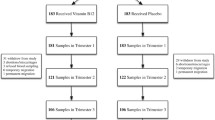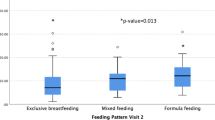Abstract
Objective
Exclusively breast-fed infants born to vitamin B12 (cobalamin, cbl)-deficient mothers can develop symptoms within a few months following delivery. The authors aimed to assess the relationship between maternal and infantile markers of cbl status.
Methods
In 240 full-term infants (age, 2–30 d) admitted to Samsun Maternity and Child Health Hospital and their mothers, complete blood count testing and serum cbl, folate and plasma total homocysteine (tHcy) measurements were performed. In the mothers, serum ferritin and holotranscobalamin (holoTC) levels were measured additionally.
Results
Among the infants, 146 (60.8%) had cbl deficiency (serum cbl <259 pg/mL), whereas 184 (76.7%) mothers had a low cbl level (serum cbl <300 pg/mL). When cbl deficiency was defined as a serum holoTC level < 40 pmol/L, 152 (63.3%) mothers were found as deficient. In addition, 147 (61.3%) infants had an elevated tHcy level (>10 μmol/L), in 35 (23.8%) of these 147 infants tHcy level being markedly elevated (>20 μmol/L). None of the infants had folate deficiency. In the correlational analysis between maternal and infantile markers associated with cbl status, the strongest correlation was observed between maternal holoTC and infantile tHcy (r = −0.49, p < 0.001), followed by the correlation between maternal tHcy and infantile tHcy (r = 0.47, p < 0.001). The weakest correlations were found between maternal cbl and infantile cbl (r = 0.28, p < 0.001), and between maternal cbl and infantile tHcy (r = −0.25, p < 0.001).
Conclusions
Maternal cbl status is an important determinant of infantile cbl status. Both maternal holoTC and tHcy may assist in predicting infantile cbl status. The finding of high prevalence of maternal and infantile cbl deficiency in this study points towards the need for effective strategies to prevent cbl deficiency in women prior to getting pregnant.
Similar content being viewed by others
References
Stabler SP. Clinical practice. Vitamin B12 deficiency. N Engl J Med. 2013;368:149–60.
Specker BL, Black A, Allen L, Morrow F. Vitamin B-12: low milk concentrations are related to low serum concentrations in vegetarian women and to methylmalonic aciduria in their infants. Am J Clin Nutr. 1990;52:1073–6.
Zengin E, Sarper N, Caki Kilic S. Clinical manifestations of infants with nutritional vitamin B deficiency due to maternal dietary deficiency. Acta Paediatr. 2009;98:98–102.
Akcaboy M, Malbora B, Zorlu P, Altınel E, Oguz MM, Senel S. Vitamin B12 deficiency in infants. Indian J Pediatr. 2015;82:619–24.
Yenicesu I. Pancytopenia due to vitamin B12 deficiency in a breast-fed infant. Pediatr Hematol Oncol. 2008;25:365–7.
Cetinkaya F, Yildirmak Y, Kutluk G, Erdem E. Nutritional vitamin B12 deficiency in hospitalized young children. Pediatr Hematol Oncol. 2007;24:15–21.
Koc A, Kocyigit A, Soran M, et al. High frequency of maternal vitamin B12 deficiency as an important cause of infantile vitamin B12 deficiency in Sanliurfa province of Turkey. Eur J Nutr. 2006;45:291–7.
Sezgin Evim M, Erdöl Ş, Özdemir Ö, Baytan B, Güneş AM. Long-term outcome in children with nutritional vitamin B12 deficiency. Turk J Haematol. 2011;28:286–93.
Seetharam B, Yammani RR. Cobalamin transport proteins and their cell-surface receptors. Expert Rev Mol Med. 2003;13:1–18.
Thompson MD, Cole DE, Ray JG. Vitamin B-12 and neural tube defects: the Canadian experience. Am J Clin Nutr. 2009;89:697S–701S.
Koebnick C, Heins UA, Dagnelie PC, et al. Longitudinal concentrations of vitamin B(12) and vitamin B(12)-binding proteins during uncomplicated pregnancy. Clin Chem. 2002;48:928–33.
Milman N, Byg KE, Bergholt T, Eriksen L, Hvas AM. Cobalamin status during normal pregnancy and postpartum: a longitudinal study comprising 406 Danish women. Eur J Haematol. 2006;76:521–5.
Morkbak AL, Hvas AM, Milman N, Nexo E. Holotranscobalamin remains unchanged during pregnancy. Longitudinal changes of cobalamins and their binding proteins during pregnancy and postpartum. Haematologica. 2007;92:1711–2.
Kalay Z, Islek A, Parlak M, et al. Reliable and powerful laboratory markers of cobalamin deficiency in the newborn: plasma and urinary methylmalonic acid. J Matern Fetal Neonatal Med. 2016;29:60–3.
Hay G, Clausen T, Whitelaw A, et al. Maternal folate and cobalamin status predicts vitamin status in newborns and 6-month-old infants. J Nutr. 2010;140:557–64.
Dayaldasani A, Ruiz-Escalera J, Rodríguez-Espinosa M, Rueda I, Pérez-Valero V, Yahyaoui R. Serum vitamin B12 levels during the first trimester of pregnancy correlate with newborn screening markers of vitamin B12 deficiency. Int J Vitam Nutr Res. 2014;84:92–7.
Casterline JE, Allen LH, Ruel MT. Vitamin B-12 deficiency is very prevalent in lactating Guatemalan women and their infants at three months postpartum. J Nutr. 1997;127:1966–72.
Greibe E, Lildballe DL, Streym S, et al. Cobalamin and haptocorrin in human milk and cobalamin-related variables in mother and child: a 9-mo longitudinal study. Am J Clin Nutr. 2013;98:389–95.
Solomon LR. Low cobalamin levels as predictors of cobalamin deficiency: ımportance of comorbidities associated with ıncreased oxidative stress. Am J Med. 2016;129:115.e9–16.
Bailey D, Colantonio D, Kyriakopoulou L, et al. Marked biological variance in endocrine and biochemical markers in childhood: establishment of pediatric reference intervals using healthy community children from the CALIPER cohort. Clin Chem. 2013;59:1393–405.
Refsum H, Grindflek AW, Ueland PM, et al. Screening for serum total homocysteine in newborn children. Clin Chem. 2004;50:1769–84.
Jones KM, Ramirez-Zea M, Zuleta C, Allen LH. Prevalent vitamin B-12 deficiency in twelve-month-old Guatemalan infants is predicted by maternal B-12 deficiency and infant diet. J Nutr. 2007;137:1307–13.
Incecik F, Herguner MO, Altunbasak S, Leblebisatan G. Neurologic findings of nutritional B12 deficiency in children. Turk J Pediatr. 2010;52:17–21.
Balci YI, Ergin A, Karabulut A, Polat A, Doğan M, Küçüktaşcı K. Serum vitamin B12 and folate concentrations and the effect of the Mediterranean diet on vulnerable populations. Pediatr Hematol Oncol. 2014;31:62–7.
Stabler SP, Allen RH. Vitamin B12 deficiency as a worldwide problem. Annu Rev Nutr. 2004;24:299–326.
Carmel R. Macrocytosis, mild anemia, and delay in the diagnosis of pernicious anemia. Arch Intern Med. 1979;139:47–50.
Obeid R, Morkbak AL, Munz W, Nexo E, Herrmann W. The cobalamin-binding proteins transcobalamin and haptocorrin in maternal and cord blood sera at birth. Clin Chem. 2006;52:263–9.
Quadros EV, Nakayama Y, Sequeira JM. The protein and the gene encoding the receptor for the cellular uptake of transcobalamin-bound cobalamin. Blood. 2009;113:186–92.
Acknowledgements
The authors would like to thank all the physicians and nurses in Samsun Maternity and Child Health Hospital for their collaboration during the collection of blood samples and data.
Contributions
EYK and MI designed the study. SC collected and processed tha data. SC, EYK and MI wrote the manuscript, and EYK revised the manuscript. EYK will act as guarantor for this paper.
Author information
Authors and Affiliations
Corresponding author
Ethics declarations
Conflict of Interest
None.
Source of Funding
Samsun Training and Research Hospital.
Rights and permissions
About this article
Cite this article
Çoban, S., Yılmaz Keskin, E. & İğde, M. Association between Maternal and Infantile Markers of Cobalamin Status During the First Month Post-Delivery. Indian J Pediatr 85, 517–522 (2018). https://doi.org/10.1007/s12098-017-2598-4
Received:
Accepted:
Published:
Issue Date:
DOI: https://doi.org/10.1007/s12098-017-2598-4




